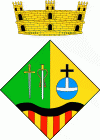La Vall de Bianya (la Vall de Bianya)
 |
La Vall de Bianya can be literally translated from Catalan as Valley of Bianya. The name is a reference to the Bianya valley, the most important landform of the municipality.
Throughout history, the word Bianya has been written with B and V (Vianya). The oldest reference to the name is from the year 958 (Vallebiania), which changed later to Bianna (1117), Bisania (1319) and finally, Bianya. During the 19th century the form Vianya (Viaña in Spanish) was also used. The form with V became the most used until the Second Spanish Republic, when Bianya was recovered. In July 1939 Vianya and Viaña were used again. Finally, with the Spanish transition to democracy, Bianya was established as the official and correct form of the name.
The origin of the name Bianya is not clear, with two main hypotheses (linked to the V and the B, respectively):
* Vianya would originate from the latin Via Annia. The ancient Romans would have given this name to the Roman road crossing the municipality. An important part of this road is still conserved nowadays and can be visited.
* Bianya would mean two rivers, in reference to the streams of Sant Ponç d'Aulina and Santa Llúcia de Puigmal. Those streams come together in Ca l'Enric and since that point the single stream is called Bianya stream. This hypothesis originates from 18th century documents that called the place Bisania. Bis would indicate repetition and ania would origin from the Latin amnis, which means river. However, documentation of the name prior to this century does not use the prefix Bis, but Bi.
Other less-accepted theories relate the name with the Celtic place name Vianna (which has been conserved as Vienne in a lot of French places), with the personal name Albiniana, or with the Arabic anthroponym Abu Gàniya.
Map - La Vall de Bianya (la Vall de Bianya)
Map
Country - Spain
 |
 |
| Flag of Spain | |
Anatomically modern humans first arrived in the Iberian Peninsula around 42,000 years ago. The ancient Iberian and Celtic tribes, along with other pre-Roman peoples, dwelled the territory maintaining contacts with foreign Mediterranean cultures. The Roman conquest and colonization of the peninsula (Hispania) ensued, bringing the Romanization of the population. Receding of Western Roman imperial authority ushered in the migration of different non-Roman peoples from Central and Northern Europe with the Visigoths as the dominant power in the peninsula by the fifth century. In the early eighth century, most of the peninsula was conquered by the Umayyad Caliphate, and during early Islamic rule, Al-Andalus became a dominant peninsular power centered in Córdoba. Several Christian kingdoms emerged in Northern Iberia, chief among them León, Castile, Aragon, Portugal, and Navarre made an intermittent southward military expansion, known as Reconquista, repelling the Islamic rule in Iberia, which culminated with the Christian seizure of the Emirate of Granada in 1492. Jews and Muslims were forced to choose between conversion to Catholicism or expulsion, and eventually the converts were expelled through different royal decrees.
Currency / Language
| ISO | Currency | Symbol | Significant figures |
|---|---|---|---|
| EUR | Euro | € | 2 |
| ISO | Language |
|---|---|
| EU | Basque language |
| CA | Catalan language |
| GL | Galician language |
| OC | Occitan language |
| ES | Spanish language |















